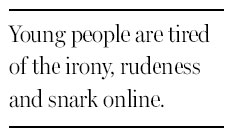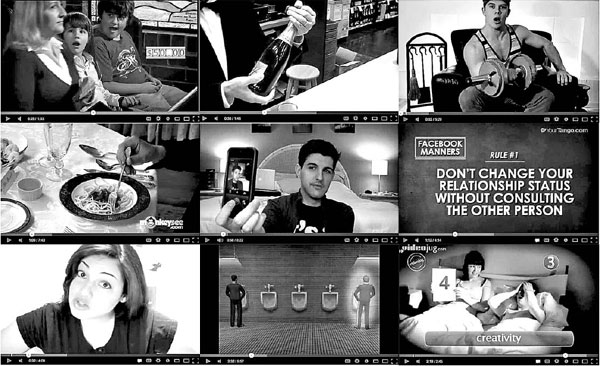Navigating manners in a digital age
Updated: 2013-04-21 07:49
By Alex Williams(The New York Times)
|
|||||||
|
Advice on what is acceptable online and smartphone behavior, called "netiquette," draws on the traditions of a more genteel era. |
A new generation of etiquette gurus, good-manner bloggers and self-appointed YouTube arbiters is rising to make old-school tactfulness relevant to a new generation.
Their apparent goal: to help members of Generation Y navigate thorny, tech-age minefields like Paperless Post invites, same-sex weddings and online dating - not to mention actual face-to-face contact with people they encounter in the offline world.
The fastest-growing area of social advice online - one that has spawned not just videos but also Web sites, blogs and books - is what's been termed "netiquette." There are YouTube videos on using emoticons in business e-mails, being discreet when posting on someone's Facebook wall, limiting baby photos on Instagram, retweeting too many Twitter messages and juggling multiple online chats.
Young people "are getting sick of the irony, rudeness and snark that is so prevalent in their online lives," said Jane Pratt, the editor in chief of xoJane, a women's lifestyle site where etiquette posts are a popular feature. "The return of etiquette is in part a response to the harshness of the interactions they are having in the digital sphere."
"Nice is very cool right now," she added.
When Daniel Post Senning, the great-great-grandson of Emily Post, was working on the 18th edition of "Emily Post's Etiquette," he found it impossible to cover technology in a single chapter. Instead, he devoted an entire book to it, "Emily Post's Manners in a Digital World: Living Well Online," being released as an e-book and paperback in April.
The book tackles questions like whether one should announce a serious illness on Facebook. (Yes, Mr. Post Senning said, but updates should be confined to close friends and family.)
Even the new gurus who position themselves as the embodiment of Old World civilities that have been coming back into fashion feel obligated to tackle 21st-century conundrums.

Charles MacPherson, who runs a school for butlers in Canada, has written his first book, "The Butler Speaks: A Guide to Proper Etiquette, Stylish Entertaining and the Art of Good Housekeeping," being released in April. An authority on such antediluvian rituals as spooning caviar, Mr. MacPherson nevertheless finds himself pondering whether one may keep a cellphone on the table during a dinner party, if the 4-year-old is at home sick with a baby sitter.
"It is never O.K. to leave your cellphone on the dinner table," Mr. MacPherson said. "Keep your cellphone on vibrate and in your pocket or on your lap. In the event that it does ring, excuse yourself from the table - don't explain why, just a simple 'excuse me' - and leave the dining room before taking the call."
Meanwhile, there is a retro allure to etiquette that appeals to 20-somethings, said Pam Krauss, the publisher of Potter Style, which in September is coming out with "Modern Manners: Tools to Take You to the Top," by Dorothea Johnson, an expert in the etiquette world. "There's a whole generation of young people for whom etiquette, much like cooking, sewing, and other 'home arts,' was not passed down from their parents or grandparents the way it would have been in years past," Ms. Krauss said.
In some circles, old-school manners, like vinyl records, single-barrel bourbon and trilby hats, are relics of the 1950s ripe to be reclaimed by young urban tastemakers, said Brett McKay, a founder of a men's lifestyle blog, the Art of Manliness. The site has popular etiquette posts drawn from the lives of George Washington and Theodore Roosevelt. The latter, for example, learned he could be more persuasive in political debates when he stopped disparaging the opposition as "oily-Gammon, churchgoing specimens" and "classical ignoramuses," according to one post on debating politics civilly.
"There's this idea in sociology that every generation rebels against its parents and makes friends with its grandparents' generation," Mr. McKay said. "The baby boomers were about 'let loose, be who you are.' The 'greatest generation' was more formal, and people want to embody some of those grandpa values."
Young women have also shown a new interest in manners, said Grace Bonney, the founder of Design Sponge, a popular home decor blog with a new weekly etiquette column.
Etiquette posts, on things like "social media dos and don'ts," have attracted five times the number of comments and Facebook "likes" as many other posts, she said.
"I think people are starting to see that it can be rewarding to put time into any effort that makes people feel more welcome in your home, whether that's a great meal, learning to arrange flowers or just general etiquette for being a good host," she said.
It is an open question whether the renewed interest will signal an actual shift in behavior.
Good manners take work, after all.
"We don't struggle for good intentions," said Nathan Tan, author of "Forgetful Gentleman," a book on etiquette being published in May. "We struggle converting our good intentions into action."
The New York Times
(China Daily 04/21/2013 page10)
